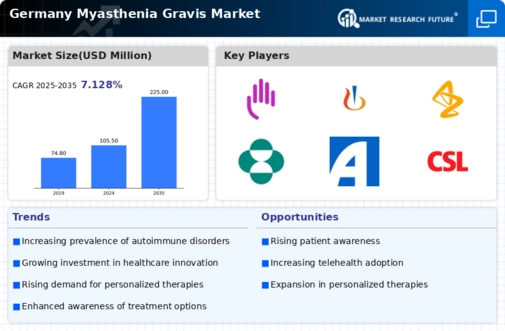Growing Awareness and Education
The myasthenia gravis market in Germany is positively influenced by growing awareness and education surrounding the disease. Increased efforts by patient advocacy groups and healthcare organizations to educate both the public and healthcare professionals about myasthenia gravis are crucial. These initiatives aim to improve early diagnosis and treatment, which can significantly impact patient outcomes. The myasthenia gravis market is likely to see a rise in demand for educational resources and support services as awareness increases. Furthermore, enhanced understanding of the disease may lead to greater patient engagement in treatment decisions, fostering a more collaborative approach to care. This trend could potentially drive market growth as patients seek out innovative therapies and support networks.
Government Initiatives and Funding
Government initiatives and funding play a crucial role in shaping the myasthenia gravis market in Germany. The German healthcare system has been proactive in supporting research and development for rare diseases, including myasthenia gravis. Funding programs aimed at fostering innovation in treatment and diagnostic methods are likely to enhance the market landscape. For instance, the German Federal Ministry of Education and Research has allocated substantial resources to support clinical trials and research projects focused on neuromuscular disorders. Such initiatives not only promote scientific advancements but also encourage collaboration between academic institutions and the pharmaceutical industry. The myasthenia gravis market stands to benefit from these efforts, as increased funding may lead to the development of new therapies and improved patient care strategies.
Advancements in Treatment Modalities
Innovations in treatment modalities are significantly impacting the myasthenia gravis market in Germany. The introduction of novel therapies, including monoclonal antibodies and immunosuppressants, has transformed the management of this condition. For instance, therapies such as eculizumab have shown promising results in clinical trials, leading to increased adoption in clinical practice. The myasthenia gravis market is witnessing a shift towards personalized medicine, where treatments are tailored to individual patient profiles. This trend is expected to enhance treatment efficacy and improve patient outcomes. As a result, the market is likely to see a surge in investment from pharmaceutical companies aiming to develop next-generation therapies that address unmet medical needs. The overall growth of the market is anticipated to be bolstered by these advancements, which may lead to a more competitive landscape.
Rising Prevalence of Myasthenia Gravis
The myasthenia gravis market in Germany is experiencing growth due to the increasing prevalence of the disease. Recent estimates suggest that the incidence rate of myasthenia gravis is approximately 5 per 100,000 individuals in Germany. This rising prevalence is likely to drive demand for effective treatment options and healthcare services. As more patients are diagnosed, the need for specialized care and innovative therapies becomes paramount. The myasthenia gravis market is thus positioned to expand, with pharmaceutical companies focusing on developing new medications and treatment protocols tailored to the needs of this growing patient population. Furthermore, the increasing awareness of the disease among healthcare professionals and the public may contribute to earlier diagnosis and intervention, further influencing market dynamics.
Technological Innovations in Diagnostics
Technological innovations in diagnostics are reshaping the myasthenia gravis market in Germany. Advances in diagnostic tools, such as high-throughput screening and genetic testing, are enabling earlier and more accurate identification of the disease. These innovations are crucial for timely intervention, which can significantly improve patient prognosis. The myasthenia gravis market is likely to benefit from the integration of advanced diagnostic technologies into clinical practice, as they facilitate better patient stratification and personalized treatment approaches. Moreover, the increasing availability of these diagnostic tools may lead to a higher rate of diagnosis, further expanding the patient population in need of treatment. As a result, the market is expected to experience growth driven by these technological advancements.

















Leave a Comment